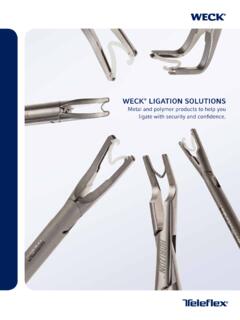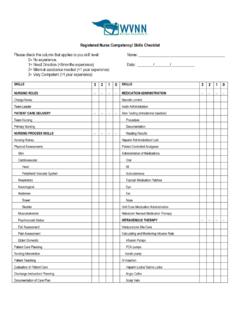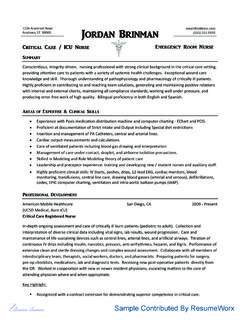Transcription of Pressure Injectable PICC Product - Teleflex
1 Ve n o u s Ac c e s s | C r i t i c a l C a r ePressure Injectable PICC ProductSingle, Two-Lumen, or Multi-LumenArrow International, Inc. 2010 Arrow International, Inc. All rights reserved. Printed in the USA. An issued or revision date for these instructions is included for user information. In the event two years have elapsed between this date and Product use, the user should contact Arrow International, Inc. to see if additional Product information is Date: August 2010Rx only. PI PICC | iiiTable of Contents Product Description 1 Indications / Contraindications 1 Pressure Injection 1 Warnings and Precautions 1 Pressure Injection Procedure 1 central Venous Pressure (CVP)
2 Monitoring 2 Guidelines 2 peripherally Inserted central catheter Warnings and Precautions 2 General 2 catheter 3 Placement Wire & Guidewire 4 Tissue Dilator 4 Peel-Away Sheath over Tissue Dilator 4 Possible Complications 4 Accessory Component Instructions 5 catheter Stabilization Device 5 catheter Trimmer 5 Dressing 6 Echogenic Needle 7 Filter Straw
3 7 Guidewire / SWG Insertion Techniques 780 cm 7130 cm 7 Maximal Barrier Drape 8 Positive Displacement Valve 9 Protected Needle 9 SharpsAway II Locking Disposal Cup 10 For reference literature concerning patient assess-ment, clinician education, insertion techniques and potential complications associated with central venous access refer to Arrow International, Inc.
4 Website: convenience, procedural and general Warnings and Precautions are listed at the beginning of the instructions. Please review all content before performing the | PI PICCPre-PICC Insertion & Patient Assessment Activities 10 Procedural Pause 10 Preparing for PICC Insertion 11 Prep Puncture Site 11 Prepare All Equipment 11 Trim catheter 11 Flush catheter
5 12 catheter Insertion Instructions 12 Gain Initial Venous Access 12 Sheath Placement 12 catheter Advancement 12 Placement Wire 12 Verify catheter Tip Placement 13 Complete catheter Insertion 13 Documentation 13 Care and Maintenance 14 Dressing 14 Maintain catheter Patency 14 catheter Removal 14 | 1 Pressure Injectable peripherally Inserted central catheter (PICC) ProductProduct DescriptionThe Arrow Pressure Injectable PICC is a peripherally inserted central venous catheter (PICC) manufactured with medical grade, flexible polyurethane.
6 The Arrow PICC has a non-tapered catheter body with either a blunt tip or a Blue FlexTip that is softer than a cut tip with a contour design to enhance maneuverability. The Blue FlexTip also provides visual confirmation of an intact catheter upon removal. The kit components assist the clinician in maintaining maximal sterile barrier :The Pressure Injectable PICC is indicated for short or long term peripheral access to the central venous system for intravenous therapy, blood sampling, infusion, Pressure injection of contrast media and allows for central venous Pressure monitoring. The maximum Pressure of power injector equipment used with the Pressure Injectable PICC may not exceed 300 psi.
7 Contraindications:This device is contraindicated wherever there is presence of device related infections, previous or current thrombosis. Clinical assessment of patient must be completed to ensure no contraindications exists. Pressure Injection Warnings and Precautions:Warnings: 1. Assess each patient for appropriateness of a Pressure injection Pressure injection procedures must be performed by trained personnel well versed in safe technique and potential complications. 3. Use an appropriate method to confirm catheter tip position prior to each Pressure injection per institutional Ensure patency of catheter prior to Pressure injection to minimize the risk of catheter failure and/or patient Discontinue Pressure injections at first sign of infiltration / extravasation.
8 Follow hospital protocol for appropriate medical Use only lumen labeled Pressure Injectable for Pressure injection to minimize the risk of catheter failure and/or patient : 1. Do not exceed the maximum Pressure of 300 psi on power injector equipment to minimize the risk of catheter failure and/or tip Do not exceed the catheter s maximum recommended flow rate located on Product labeling to minimize the risk of catheter failure and/or tip Warm contrast media to body temperature prior to Pressure injection to minimize the risk of catheter Pressure limit settings on power injector equipment may not prevent over pressurization of an occluded Use an appropriately rated 60 inch Pressure tubing between catheter and power injector equipment to minimize the risk of catheter Follow the specified contrast
9 Media manufacturer s instructions for use, warnings, precautions, and Injection Procedure:NOTE: Clinicians should use sterile technique when flushing, disconnecting, connecting, and replacing injection/needleless Use an appropriate method to confirm each tip placement prior to each Pressure injection per institutional Remove injection cap from the lumen of catheter to be Check for catheter patency: Attach 10 mL syringe, or larger, filled with sterile normal saline. Aspirate catheter until approximately 3 mL of blood enters syringe freely. Vigorously flush catheter . Warning: Ensure catheter patency prior to Pressure injection to minimize the risk of catheter failure and/or patient Detach Attach Pressure injection equipment and extension tubing to lumen of catheter according to manufacturer s : Use only lumen labeled Pressure Injectable for Pressure injection to minimize the risk of catheter failure and/or patient : To minimize risk of catheter failure and/ortip displacement: Do not exceed the maximum Pressure of 300 psi on power injector equipment.
10 Do not exceed the catheter s maximum recommended flow rate located on Product Inject contrast media in accordance with hospital : Warm contrast media to body temperature prior to Pressure injection to minimize the risk of catheter Disconnect catheter from power injector Flush catheter with a 10 mL syringe, or larger, filled with sterile normal Replace sterile injection cap on : catheter testing included 10 Pressure injection | central Venous Pressure (CVP) Monitoring Guidelines: Perform chest x-ray or other means of catheter tip placement verification prior to monitoring CVP. Flush catheter with sterile normal saline to ensure patency of catheter prior to monitoring CVP.








